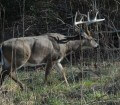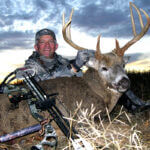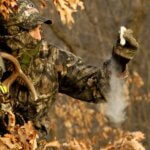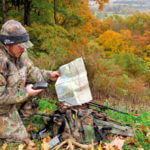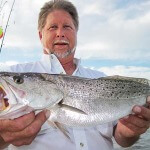John’s Note: When you do everything right on your hunt, why doesn’t a buck show up when you expect him? We all often ask this question, but we rarely get a satisfactory answer. About 90% of the deer harvested each season are taken while moving and feeding. Rarely will a hunter find and take a bedded-down buck. If you know when, why, where and how deer move, you more realistically can predict when the buck should come in to you.
 * Allow someone to push a buck to your stand. According to the late James G. Teer of the Welder Wildlife Foundation in Texas, “Hunting pressure increases the deer’s flight distance. When a deer at the Wildlife Foundation encounters a man, it only will run about 50 yards before it stops, looks back and continues on its daily routine. However, the deer at the Foundation have become relatively tame. But when you hunt in an area with other hunters, the deer may run 200 to 300 yards once spooked before they stop to look back and try and determine whether or not they need to continue to run. The less hunting pressure exerted on a deer, the more likely he’ll be to move during daylight hours.”
* Allow someone to push a buck to your stand. According to the late James G. Teer of the Welder Wildlife Foundation in Texas, “Hunting pressure increases the deer’s flight distance. When a deer at the Wildlife Foundation encounters a man, it only will run about 50 yards before it stops, looks back and continues on its daily routine. However, the deer at the Foundation have become relatively tame. But when you hunt in an area with other hunters, the deer may run 200 to 300 yards once spooked before they stop to look back and try and determine whether or not they need to continue to run. The less hunting pressure exerted on a deer, the more likely he’ll be to move during daylight hours.”
With this knowledge, you can set-up a game plan that will cause bucks to come by your stand by following these steps: get an aerial photo of the land you plan to hunt; mark the places on the roads where most hunters enter the woods; and determine the distance of a 1/2-mile from the point at which other hunters will enter the woods. Because a deer will run almost 400 yards before it stops to look back, any deer that gets within 800 yards of you and any point at which any of the hunters enter the woods, should move past you during the first hour of the time you hunt. Using this technique, hunting pressure becomes an advantage instead of a disadvantage.
* Hunt dry weather. Both Charles DeYoung, another Texas deer biologist, and the late James G. Teer agreed that deer move more during dry-weather conditions than at most other times. The deer have to move to find more sources of food and water during this time of the year. As Ronnie Groom, a deer seminar instructor, explains, “Clear-cuts provide great places to hunt throughout most of the year. However, during drought conditions, deer will avoid clear-cuts because these open spaces often will become extremely hot and dry. If you want to take a buck during a drought, hunt creek bottoms and the edges of lakes and streams. Deer will find both water and food in these areas.”
 * Hunt the deer’s dinner table. If you know the deer’s preferred food in your area at the time of the year that you plan to hunt, find that food source. To learn this information, contact your state’s Wildlife Section, and speak to the district biologist in the area where you’ll hunt. Dr. Karl Miller, a professor of wildlife at the University of Georgia, mentions, “Deer will move to feed on preferred food sources like muscadine grapes, persimmons and white oak acorns in the South.” The late James G. Teer explained, “Although deer browse, they will travel across hundreds of acres to get to a preferred food source like acorns.” But deer-hunting seminar expert Ronnie Groom pinpoints the preferred food source even better. “Deer become more active when a tree drops its acorns, especially white oak acorns. I’ve observed that where white oak acorns fall the heaviest, you’ll see the most deer moving to these trees throughout the day.”
* Hunt the deer’s dinner table. If you know the deer’s preferred food in your area at the time of the year that you plan to hunt, find that food source. To learn this information, contact your state’s Wildlife Section, and speak to the district biologist in the area where you’ll hunt. Dr. Karl Miller, a professor of wildlife at the University of Georgia, mentions, “Deer will move to feed on preferred food sources like muscadine grapes, persimmons and white oak acorns in the South.” The late James G. Teer explained, “Although deer browse, they will travel across hundreds of acres to get to a preferred food source like acorns.” But deer-hunting seminar expert Ronnie Groom pinpoints the preferred food source even better. “Deer become more active when a tree drops its acorns, especially white oak acorns. I’ve observed that where white oak acorns fall the heaviest, you’ll see the most deer moving to these trees throughout the day.”
* Learn how noise will move bucks. “Unfamiliar noises make the deer move either to you or away from you,” DeYoung says. “But they quickly learn to adapt to unthreatening noise. For instance, a deer may bed down near a busy highway. I once observed deer in Ft. Sill, Oklahoma, bedding down on the artillery range, even when the rounds went off. I believe that once deer become accustomed to a sound, it no longer frightens them.” So, look for places to put your tree stand where noises that normally spook deer don’t spook deer. One hunter in my area took a buck each year that scored more than 150 Boone and Crockett points by bowhunting less than 200 yards from a campground and picnic area in a national forest. Another friend of mine bagged a buck that scored 168 points B&C less than 100 yards from a dog pen filled with yapping beagles.
 To get John E. Phillips’ Kindle eBooks and print books on hunting deer, “How to Hunt and Take Big Buck Deer on Small Properties,” “How to Hunt Deer Up Close: With Bows, Rifles, Muzzleloaders and Crossbows,” “PhD Whitetails: How to Hunt and Take the Smartest Deer on Any Property,” “How to Take Monster Bucks,” “How to Hunt Deer Like a Pro,” and “Bowhunting Deer: Mossy Oak Pros Know Bucks and Bows,” or to prepare venison, “Deer & Fixings,” click here.
To get John E. Phillips’ Kindle eBooks and print books on hunting deer, “How to Hunt and Take Big Buck Deer on Small Properties,” “How to Hunt Deer Up Close: With Bows, Rifles, Muzzleloaders and Crossbows,” “PhD Whitetails: How to Hunt and Take the Smartest Deer on Any Property,” “How to Take Monster Bucks,” “How to Hunt Deer Like a Pro,” and “Bowhunting Deer: Mossy Oak Pros Know Bucks and Bows,” or to prepare venison, “Deer & Fixings,” click here.
For information on making jerky from your deer to provide a protein-rich snack, you can download a free book from https://johninthewild.com/free-books.


